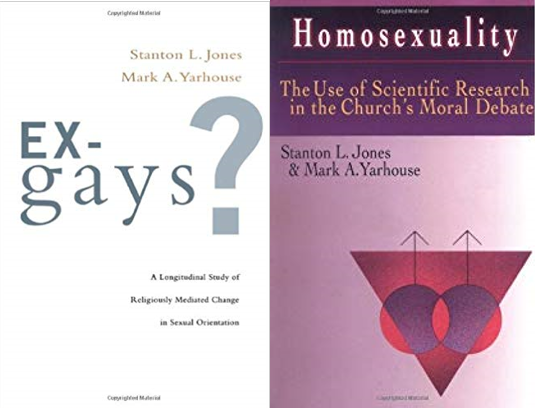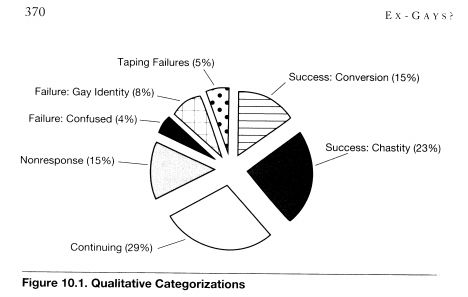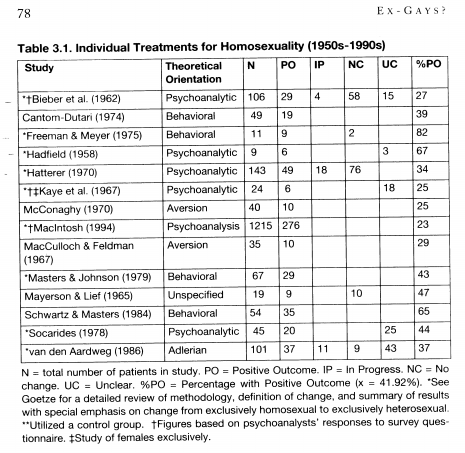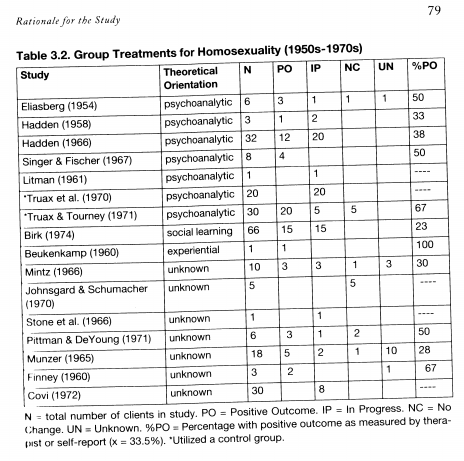Can Practising Homosexuals Experience Change through Counselling?
A Report by Stanton Jones & Mark Yarhouse. Publication Sources: Ex-Gays? A Longitudinal Study of Religious Mediated Change in Sexual Orientation. IVP, 2007 and Homosexuality: The Use of Scientific Research in the Church’s Moral Debate (IVP, 2009).
Publication Sources: Ex-Gays? A Longitudinal Study of Religious Mediated Change in Sexual Orientation. IVP, 2007 and Homosexuality: The Use of Scientific Research in the Church’s Moral Debate (IVP, 2009).
Summary of research: [Stanton Jones, Same Sex Science, First Things Feb 2012]
We are told that homosexual persons are just as psychologically healthy as heterosexuals, that sexual orientation is biologically determined at birth, that sexual orientation cannot be changed and that the attempt to change it is necessarily harmful, that homosexual relationships are equivalent to heterosexual ones in all important characteristics, and that personal identity is properly and legitimately constituted around sexual orientation. These claims are as misguided as the ridiculed beliefs of some social conservatives, as they spring from distorted or incomplete representations of the best findings from the science of same-sex attraction.
Contrary to the assumptions of many social conservatives, biology does appear to play a modest part in determining sexual orientation. Contrary to the assumptions of many social progressives, psychological and environmental variables also appear to play at least a modest part in determining sexual orientation. In contrast to the hubris of those prone to making emphatic pronouncements, what we do not yet know about the causation of sexual orientation dwarfs the bit that we are beginning to know. And the fact that causation is indubitably a complex and mysterious by-product of the interaction of biological and psychological variables confounds the assertion that sexual orientation is just like skin color, determined at birth or even conception. And contrary to the suggestions of some, the involvement of some biological influence does not prove that change in sexual orientation is impossible. One of our foremost behavior genetics experts, Thomas Bouchard, has argued forcefully that “one of the most unfortunate misinterpretations of the heritability coefficient is that it provides an index of trait malleability (i.e., the higher the heritability the less modifiable the trait is through environmental intervention).”
Of the 61 subjects who completed the study, 23 percent reported success in the form of “conversion” to heterosexual orientation and functioning, while 30 percent reported they were able to live chastely and had disidentified themselves from homosexual orientation. On the other hand, 20 percent reported giving up and fully embracing homosexual identity, and the remaining 27 percent continued the process of attempted change with limited and unsatisfactory success. On average, statistically significant decreases in homosexual orientation were reported across the entire sample, while a smaller but still significant increase of heterosexual attraction was reported. The attempt to change orientation was not found to lead to increases in psychological distress on average; indeed, the study found several small significant improvements in psychological distress associated with the interventions. And lest we fall prey to the same mistakes we have been criticizing in others, we have said repeatedly that because our sample was not demonstrably representative of those seeking change among all religious homosexuals, these are likely optimistic outcome estimates.
I conclude that homosexual orientation is, contrary to the supposed consensus, sometimes mutable. “Homosexuality” is a multifaceted phenomenon; there are likely many homosexualities, with some perhaps more malleable than others. Not all interventions are the same; not all practitioners are equally skilled. Perhaps most important, those seeking change vary considerably in their intensity of motivation, in their resourcefulness, and in the context in which they try to change. Most of those seeking change and most of those who actually attain some level of change are highly religiously committed, and these individuals who believe in a God who intervenes in their lives are embedded in communities of care and are motivated by their core understanding of who they are as a person before God. It is a wonder that anyone without such resources successfully obtains sexual-orientation change.
Excerpts taken from Ex-Gays? A Longitudinal Study of Religious Mediated Change in Sexual Orientation. IVP, 2007
Conclusion
[In conducting this study we found empirical evidence that change of homosexual orientation may be possible through involvement in Exodus ministries, either (1) in the form of an embrace, or (2) in the form of a diminishing of homosexual attraction and an increase in heterosexual attraction with resulting satisfactory heterosexual adjustment. These latter individuals regard themselves as having changed their sexual orientation; the former regard themselves as having re-established their sexual identities to be defined in some way other than by their homosexual attractions.] (pp. 364-365)
What Did We Find?
Qualitative analysis of sexual orientation outcomes
In chapter eight we presented out qualitative analyses and some post hoc (after the fact) quantitative analyses of our findings. Participants were categorized on the basis of their self-reports in interviews in one of six categories; we report the percentages in each category in parentheses:
– “Success: Conversion” (15%): The subject reports considerable resolution of homosexual orientation issues and substantial conversion to heterosexual attraction.
– “Success: Chastity” (23%): The subject reports homosexual attraction is either missing or present only incidentally and in a way that does not seem to bring about distress.
– “Continuing” (29%): The person may have experienced diminution of homosexual attraction, but is not satisfied and remains committed to the change process.
– “Nonresponse” (15%): The person has experienced no significant sexual orientation change. The subject has not given up on the change process, but may confused or conflicted about which direction to turn next.
– “Failure: Confused” (4%): The person has experienced no significant sexual orientation change and has given up on the change process but without yet embracing gay identity.
“Failure: Gay Identity” (8%): The person has clearly given up on the change process and embraced gay identity. [pgs. 368-369]

It may interest the reader to compare the findings of the present study with the findings of earlier researchers given below:


The two tables are printed in both their books Ex-Gays (IVP, 2007) and
Homosexuality: The Use of Scientific Research in the Church Moral Debate. (IVP, 2000).
[Change is possible but it varies from individual to individual. The notion that therapies to change sexual orientation is discredited based on ideological presupposition needs to be re-examined in the light of cases of relatively successful change]
First, we found that some respondents experienced significant, meaningful change of sexual orientation in this sample, but we did not find that everyone (or anyone) can change.
Second, while we found that a part of our research population experienced success to the degree that it might be called (as we have here) “conversion,” we have insufficient evidence to conclude that these changes are categorical, resulting in uncomplicated, dichotomous and unequivocal reversal of sexual orientation from utterly homosexual to utterly heterosexual. [pg. 372]
Sixth, we cannot validate that the significant changes experienced by the Exodus successes in this study are permanent or utterly pervasive…
It must remembered that all reports of outcomes in behaviour change intervention studies are provisional, at this time. Persons cured of addictions relapse; individuals who alter their behaviour lapse back into old patterns. That an individual is free of a type of distress at one assessment does not guarantee that the change will endure. [p. 375]
Ninth, despite our findings that on average participants experienced no harm from the attempt to change, we cannot conclude that specific individuals are not harmed by an attempt to change.
Specific individuals may claim to have experienced harm from the attempt to change, and those claims may be legitimate. Genuine and tragic harm may indeed result from intervention methods that are inept, harsh, punitive or otherwise ill-conceived. Additionally, specific individuals may be psychologically fragile in such ways that well-meaning interventions that would not cause harm to most other persons may be traumatic to those persons. It is also necessary to say that claims of harm may be ideologically based and exaggerated for the sake of foreclosing the option of the attempt to change. [p. 375-376]
[Robert Perloff, a past-president of APA] concluded that “the research on sexual conversion is … a work in progress, an open question.” This study adds substantial evidence that change of orientation is indeed possible for some persons, and that the risks of harm have been exaggerated. [p. 379]
Respect for the autonomy and self-determination of clients, regard for diversity of viewpoints in a pluralistic culture, and the existing body of scientific research (including, now, the present investigation) all favour the viability of religion-based change ministries. To the extent that negative professional attitudes toward the various reorientation therapies are grounded in the raw assertion that orientation change is impossible, this study serves to undermine that pessimism. This is not meant to diminish the experiences of those in the gay community who see such programs as highly political or even personally offensive, but is a call for fairness, professionalism and ethical practice on behalf of a diverse and pluralistic culture, as well as a similarly diverse client population. [p. 382]
CONCLUSION
In the end we believe we have provided evidence that change of homosexual orientation may be possible through involvement in Exodus ministries. The change may take the form of a reduction in homosexual attraction and behavioural chastity; it may also take the form of a reduction in homosexual attraction and an increase in heterosexual attraction with what might be described as satisfactory adjustment. Those who report chastity regards themselves as having re-established their sexual identities to be defined in some way other than by their homosexual attractions. Those who report a heterosexual adjustment regard themselves as having changed their sexual orientation.
We also found little evidence that involvement in the Exodus change process was harmful to participants in this study. Taken together, these findings would appear to contradict the commonly expressed view of the mental health establishment that change of sexual orientation is impossible and that the attempt to change is highly likely to produce harm for those who make such an attempt. [p. 387]
Quote from Post-Script by Mark Yarhouse, A Christian Perspective on Sexual Identity (2013)
At the time of our original publication, we categorized participants based on what they said of their change efforts. We used categories such as “success” and “failure” only with reference to the goals of the participants themselves, in terms of being a part of Exodus to experience a change in attractions or orientation. In total, participants fell into six categories. We indicated that 15% were what we called Success: Conversion (which reflected a conversion from homosexuality to heterosexuality), while 23% were categorized as Success: Chastity (or a sufficient reduction in same-sex attraction so that the person reported the freedom to live chaste without it being the burden it once was). Another 29% of the participants were categorized as Continuing change effort, which meant there was some reduction in attraction but not enough to describe themselves as having experienced success. Fifteen percent of participants were designated as having No Response to change effort. Four percent were categorized as Failure: Confused, while 8% were designated Failure: Gay Identity.
Our updated results after six to seven years in the change effort suggested that the average changes made were able to be sustained over time. As with the changes reported after three years in a change attempt, the average gains of diminished same-sex attraction (or away from homosexuality) were stronger than the average gains of increased opposite-sex attraction (or toward heterosexuality). In this assessment, we asked people how they would designate themselves in light of the previous categories we had used, and Success: Conversion (to heterosexuality) rose to 23% of the remaining sample, while Success: Chastity also increased to 30% of the sample.
As important as these findings are for those considering a change attempt, most people do not experience change of sexual orientation; the reported changes are best thought of as gains along a continuum of attraction rather than categorical changes from homosexual to heterosexual. Indeed, most people who report a heterosexual outcome would acknowledge some experiences of attraction to the same sex.
Jones & Yarhouse presented an update of their research in a paper, at the Sexual Orientation and Faith Tradition Symposium at the American Psychological Association (2009). See also, “A Longitudinal Study of Attempted Religiously Mediated Sexual Orientation Change,” which appeared in the Journal of Sex & Marital Therapy (2011), pp. 404-27.
Related Posts:
Practising Homosexuals Can Change: A Simple Biblical Argument & Social-Scientific Evidence. Part 1/2
A Scripture-Principled and Pastoral-Sensitive Church Response to Homosexual Activism